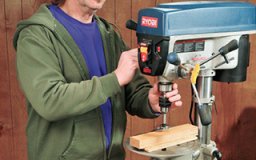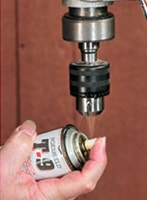How to Maintain Your Drill Press

While it's relatively maintenance-free, that doesn't mean that you shouldn't do regular check-ups and lubrication of your shop's drill press. A drill press is a pretty simple looking machine: just a chuck at the end of a spindle that holds a drill bit, and allows it to move up and down while it’s spinning. But there are a number of things that can get out of kilter that compromise drilling performance and accuracy.
These include issues with the machine’s pulleys and drive belt, spindle and chuck and the table and column. Fortunately, it doesn’t take a lot of time or effort to do a few basic maintenance tasks that help keep your drill press running smoothly. Unless otherwise specified, all the procedures described in this article should be performed with the drill press unplugged from electrical power. We’ll start out by cleaning and lubricating the tool, but as stated, there are many things you can do to improve your drill press’s performance and longevity.

Put some rust protectant and lubricant (like this Boeshield T-9) on drill chuck to keep the press running uninterrupted. If the outside of your drill press’s steel and iron parts are rusty or dirty, clean them off using either a rust remover such as Naval Jelly for heavier rust deposits, or a cleaning solvent/degreaser for lighter grime. Use a plastic abrasive pad or steel wool to scrub the surfaces. Wipe all parts dry with a clean rag. To keep the column, table, chuck and other bare metal surfaces from corroding, coat them with a protective spray, such as Bullfrog Rust Blocker. It’s also a great idea to vacuum out any sawdust from the machine’s motor and electrical switch boxes. To keep the chuck’s jaws operating smoothly — essential to proper bit centering — apply a little drying lubricant, such as Boeshield T-9, inside of the chuck: First, however, turn the chuck’s shell until the jaws are fully open and blow the inside clean with a burst of compressed air (wear goggles to keep flying dust out of your eyes). Spray or squirt some lubricant up inside and tighten and loosen the jaws a few times while the excess lube drips out. Wipe off any residue with a clean rag.
Keep the inspiration coming!
Subscribe to our newsletter for more woodworking tips and tricks


